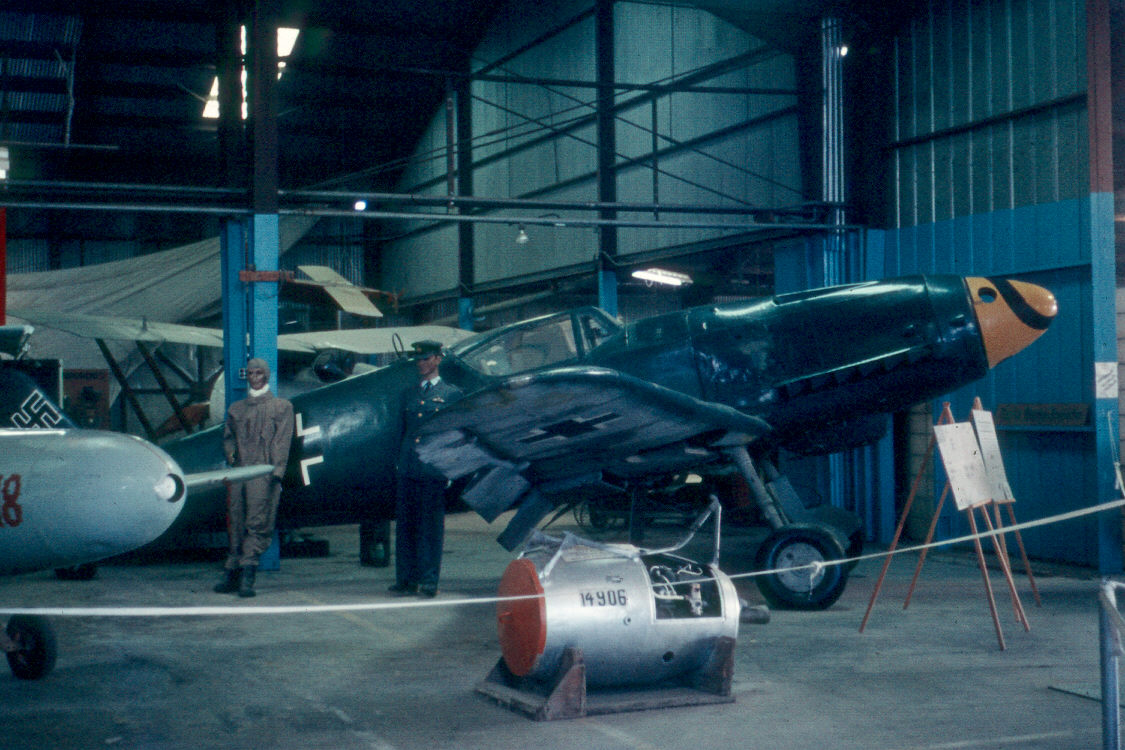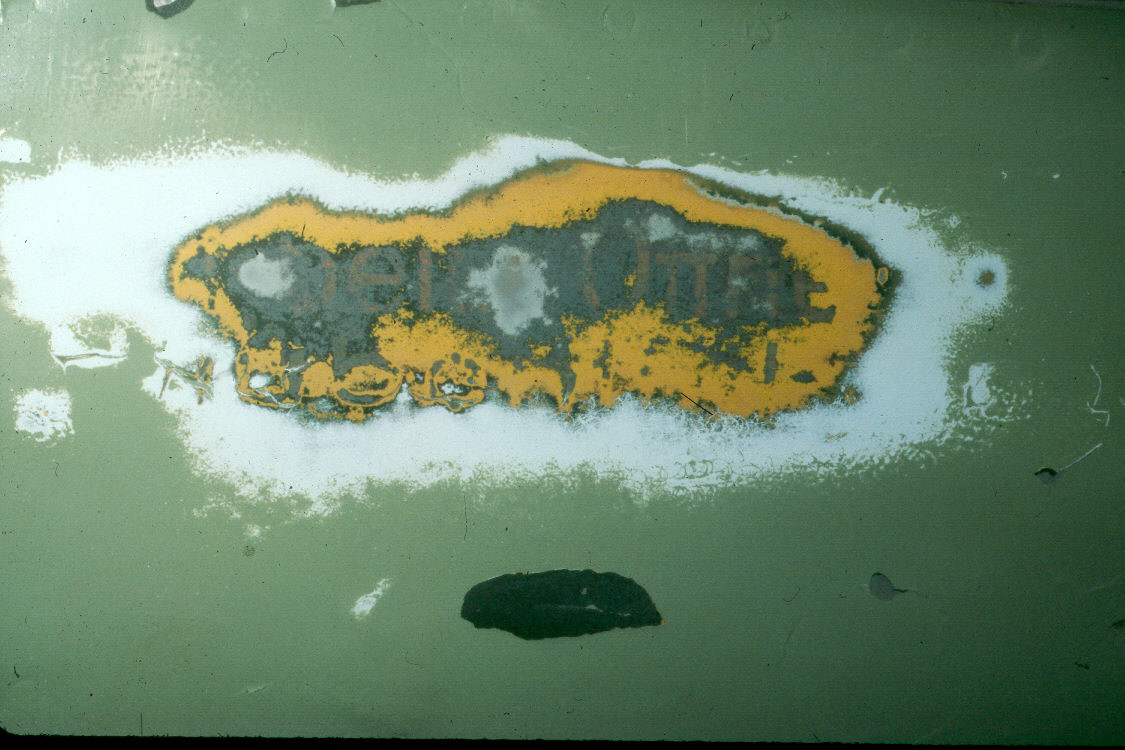Bf-109 G-10/U4 W.Nr. 611943
History
Of the
three Bf-109 G-10 models left in existence today, this example is in the
most original condition. Although a few components were missing, the
wings, engine, fuselage and even the tail group are all part of the
original airframe as manufactured in 1944.
As with
most Bf-109 G-10 models, this machine had two manufacturer’s data plates.
The aircraft’s werk nr. 611943 can be confirmed from the original data
plates along with the same number painted on the inside of the fuselage,
across from the radio access hatch. Unfortunately these data plates later
turned up missing, but a corner of one of these plates was found during
restoration underneath the curved cuff - style fairing, near the cockpit.
The recovered piece is of an early type data plate, common to the G-6. We
also have the surviving notes as to what was on these plates, taken by the
aircraft’s owner, Mr. Ed Maloney. They read, Bf-109 G-10/U4, Mfg.
Augsburg, Germany 1943. Werk Nr. 611943, Modified 12 /44.
As this
werk nr. is consistent with number blocks assigned to the Weiner
Neustadter Works and the first G-10 models made their service debut in
Oct./Nov. 1944, it is my opinion that this aircraft was manufactured from
a repairable G-6 airframe or pre-existing G-6 fuselage.
Originally known as, “Yellow 13” of II Gruppe, JG 52. This aircraft was
surrendered to American forces in the Gruupe’s attempt to escape advancing
Russian forces and flown to Neubiberg Airfield, near Munich.
This
machine was one of three G-10 models collected from this location by a
unit of Watson’s Wizzers, commanded by Capt. Fred Macintosh. Capt.
Macintosh was in charge of collecting piston engine examples of Luftwaffe
aircraft for shipment to the United States.
Yellow
13 may have been test flown at this time, but it was reported that the
airframe made its journey to the harbor of Cherbourg by truck. It was then
loaded on to the aircraft carrier HMS Reaper along with many other
examples of Luftwaffe aircraft and left port on July 19, 1945. Arriving at
pier 14 in New York Harbor some 12 days later, Yellow 13 was then off
loaded onto a barge and taken to Ford AAF in Newark, NJ where it was
stored and eventually crated for shipment in Sept. 1945.
Yellow
13 was shipped to Freeman Field in May 1946 but transferred to Wright
Field in June 1946 to be used for display purposes. At this point the
aircraft was assigned the code; FE-122, later changed to T2-122, when the
Technical Data Laboratory section of the Air Material Command became part
of T2 Intelligence.
It was
during this period that T2-122 acquired a rather spurious dark green paint
job with a yellow nose. The aircraft had also lost a few of its original
components. It was restored by (believe it or not) fitting a P-51 tail
wheel and the propeller from a P-38, along with a non standard spinner
that was later found to be from an Fw-190 with a piece of sheet metal
added to fair it to the cowling!
By 1947
T2-122 was declared surplus and donated to the University of Kansas at
Lawrence. The University held the airframe in storage at the local airport
and later transported it to the campus for display during an engineering
exposition in April 1948. The aircraft was displayed along with a He-162
Volksjager. (W.Nr. 120077 / T2-489) Except for reattaching the wings and
cleaning the airframe to make her look presentable, no restoration work
was done on T2-122 during this time.
In 1948
T2-122 was sold to dealer/collector Eddie Fisher of Kansas City, Kansas.
Mr. Fisher stored the aircraft and no restoration work was performed on
the airframe.
In 1958
Mr. Fisher sold T2-122 to Ed Maloney, founder of the Planes of Fame
Museum. Mr. Maloney had the aircraft trucked to California. T2-122 was to
become one of the cornerstones of Mr. Maloney’s newly founded Air Museum.
During
the 1960s and 70s The Planes of Fame Museum had moved to various sites, as
Mr. Maloney was trying to find suitable quarters to house and display his
growing collection. T2-122 had changed locations (and paint schemes)
several times. Starting out in an old tree nursery building in Claremont,
CA in 1962, the museum later moved to a hanger at Ontario Airport by the
late 1960s.
Operating expenses had compelled Mr. Maloney to split up his collection
in the 1970s. Airworthy aircraft went to Chino Airport, while the
non-flyable machines (T2-122 among them) went to Anaheim. Eventually the
Anaheim Museum closed down and all the aircraft were consolidated at Chino
Airport. During this time, T2-122 was never actually restored but had been
repainted several times.
T2-122
was also loaned to Universal Studios to be used as a prop in the 1975
movie, “The Hindenburg”, starring George C. Scott. The studio was
responsible for one of the more outlandish of the many paint schemes this
machine has carried in its career.
In 1978,
restoration expert, Richard P. Lutz Jr. volunteered his services to
recondition T2-122 in what has become the best known and most photographed
paint scheme of the aircraft’s history.
Mr. Lutz
was able to sand down through many layers of paint to uncover the original
colors, markings and stencils. From this, Mr. Lutz was able to hand cut a
complete set of stencils to give the aircraft accurate markings. The
airframe was painted in its original colors of RLM 74/ 75/ 76 using a
standard factory camouflage drawing as a reference
Later on
Mr. Lutz and the museum staff were able to restore a more realistic
propeller and spinner by casting fiberglass copies, using the propeller
blades from John Caler’s G-10 (W.Nr. 610824 / T2-124) and a spinner from
NASM’s Me-410 (W.Nr. 10018 / T2-499) as mold patterns.
T2-122,
Yellow 13” has remained in Mr. Maloney’s collection now for the past 44
years. In the 1990s the aircraft was transferred to the Planes of Fame
Museum’s Arizona branch and once again repainted. It remains on display at
Grand Canyon Valle airport in Arizona.
Sources:
War
Prizes, by Phil Butler
German A/C Interiors 1935-1945 vol.1 by Kenneth A. Merrick
University of Kansas archives, courtesy of Barry Bunch
Correspondence with: Richard P. Lutz Jr. and Ed Maloney
Indiana Military Org's web site at
www.indianamilitary.org/FreemanAAF/index.htm
Photos
All photographs are
courtesy of Mr. Richard P. Lutz Jr.

Over painted in green
at Ontario Airport, November 1967. Note the non-standard spinner.

Painted in Erich
Hartman’s markings at Anaheim, November, 1972

The “Hindenburg”
movie paint job getting ready to receive yet another repainting at Chino,
November 1978.

Sanding through many
layers of old paint to uncover the original markings. “beim Offnen” is
revealed on the oil cooler cowling, under the nose

Repainting completed,
courtesy of Richard P. Lutz Jr. This is the aircraft’s best-known paint
scheme. On display at the Chino air show, May 1981.

The old nose, (left)
made from a FW-190 spinner with a piece of sheet metal added and the new
nose cast from the spinner of a ME-410, loaned to the museum by NASM

Luftwaffe ace Walter
Schuck visits the museum and tries on Yellow 13’s cockpit for size.

T2-122 “Yellow 13” as
it appears today, on display at Grand Canyon Valle Airport, in Arizona.

“Oberst von Lutz”
posing in the Chino museum’s Bf-109 G-6, rebuilt from an ex-Spanish Air
Force machine. Restoration expert and collector, this article would not
have been possible without his help and generosity. I owe him a debt of
gratitude.
Richard Corey
email:
crich111@adelphia.net |


 James D. West
James D. West 







